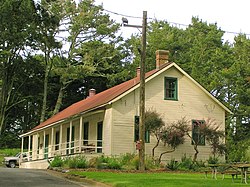Fort Miley Military Reservation
| Fort Miley Military Reservation | |
|---|---|
| Near San Francisco, California in United States | |

Ordnance storehouse, the only Fort Miley building from before 1934
|
|
| Coordinates | 37°46′55.72″N 122°30′19.95″W / 37.7821444°N 122.5055417°WCoordinates: 37°46′55.72″N 122°30′19.95″W / 37.7821444°N 122.5055417°W |
| Type | coastal defense |
| Area | 54 acres (21.85 ha) |
| Site information | |
| Owner | United States Army |
| Controlled by | United States Army Coast Artillery Corps |
| Site history | |
| Built | 1899 |
| Fate | Decommission 1948 |
| Location | San Francisco, California |
| NRHP Reference # | 80000371 |
| Added to NRHP | May 23, 1980 |
The Fort Miley Military Reservation, in San Francisco, California, sits on Point Lobos (not to be confused with Point Lobos near Carmel-by-the-Sea), one of the outer headlands on the southern side of the Golden Gate. Much of the site is part of the Golden Gate National Recreation Area, while the grounds and buildings that were converted into the San Francisco VA Medical Center are administered by the Veterans Health Administration of the US Department of Veterans Affairs.
In 1885, United States Secretary of War William C. Endicott, heading the Board of Fortifications, issued a report necessitating the coastal defense of San Francisco Bay. By September 1890, Colonel George Mendel, the army engineer officer in charge of defense construction in the San Francisco region, had selected for fortification a 73-acre (29.5 ha) tract of land near Point Lobos which belonged to the City of San Francisco and since 1868 had been the Golden Gate Cemetery. After much intrigue and various maneuverings, the Federal government secured in 1891 condemnation of 54 acres (21.85 ha) for $75,000.
It was still some years before the army did anything with its new Point Lobos Military Reservation. The Spanish–American War of 1898 provided the needed stimulus and that year the first two buildings were built there to house a small Signal Corps detachment whose mission is now long forgotten, though it may have been to provide a warning of the approach of enemy ships during that war.
...
Wikipedia




